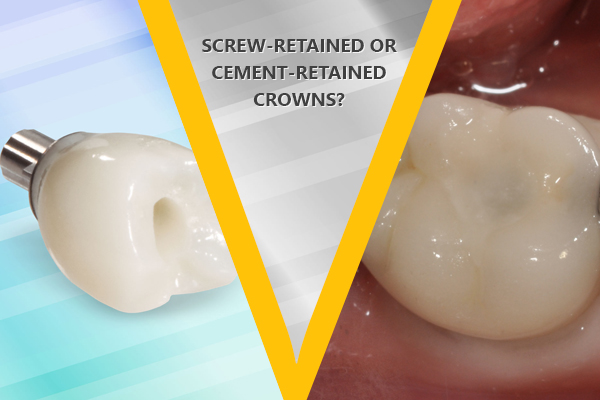Screw-Retained or Cement-Retained Crowns – Which One Is Better?

When you go for the dental implants to replace your damaged or missing teeth, there are two basic steps that the dentist will follow to complete the procedure – the placement of the implants and the attachment of the crowns with the abutments. The former is a universal method that is followed in the same manner by all the dentists. The latter is a method that has two different options altogether, the screw-retained and the cement-retained crowns.

Which one is a more suitable method is subject to debate on. Both have their advantages and disadvantages. Different dental situations and other factors can help you to determine, which crown retention method is more preferable to the other.
In terms of cost, the cement-retained crowns are more affordable and quite inexpensive. The clinical prosthodontics techniques that are used in fabricating these retentions are very affordable and can be fabricated at the conventional laboratories.
The screw-retained crowns on the other hand, are more expensive and have a number of extra components to take into consideration. These are –
These factors increase the price. However, when due to biological and technical complications, the cement based retentions get damaged, the cost of retrieving them, must also be considered. The screw based retentions exclude these costs as damages are remote.
In case of aesthetic areas, the screw based restorations were not used previously. However, the facial screw access channel can be changed into lingual screw access channel with the help of custom abutments and pre-angled abutments. Hence, even in optimal position, both these types are suitable.
For long, dentists have argued that for posterior teeth accessibility, the cement-retained restorations perform better. However, with an angled ability and with a low vertical clearance, dentists can change the angle of the anterior abutments up to 25 degrees and retrieve the posterior ones. As you visit a battersea dentist, you will know about this procedure in details.
The cement-retained restorations ensure stable and optimal occlusal contacts. This is because no occlusal screw access hole is there. When lateral and protrusive excursions interfere with the screw access holes, they compromise the anterior guidance.
This is the most important factor associated with the longevity of implant prosthesis. Surface area, height, taper of abutment, type of cement, surface roughness etc. factors are associated with cement-retained restorations.
In case of screw-retained restorations, the retention longevity is affected by the loosening of the screw as the screws fasten the restoration with the abutment. The screw settling, insufficient clamping force, off-axis centric forces, prosthesis misfit, biomechanical overload, component of the implant, implant diameter, hex height and design of the screw are the most important factors that affect the loosening and fastening of the screw.
In case of screw-retained restorations the fit between the abutment and the crown has to be precise. Otherwise, the implant, the prosthesis and the surrounding bone may undergo substantial stress. Cast accuracy, impression technique, skill of technician and casting and component tolerance play the major role in the fabrication of the prosthesis. When the two types of restorations are compared, the screw-retained ones ensure tighter margins. Many believe that cement can absorb the shock and thereby, protect the bone and the prosthesis, whereas, it has a higher risk of gingivitis or bacterial growth.
In some cement-retained restorations, gingival inflammation can be a problem, if the excess cement is not properly removed. It can lead to peri-implant inflammation, soreness, swelling of soft tissue, resorption of peri-implant bone and bleeding. The dentists battersea will discuss about this in details.
If you are looking for an option that would ensure immediate loading, the screw retained one is the better option as it eliminates the need to remove the excess cement associated with the cement-retained restorations.
In case of screw retained restorations, porcelain fracture is a common problem as during the procedure, the screw access hole damages and fractures the porcelain structure.
Studies have shown that, when the cement-retained restorations and the screw retained restorations were compared, more complications were associated with the screw retained ones. Though minimal and controllable, the number of higher in case of screw retained procedure than in cement retained one.
Conclusion:
The visiting the best dentist in battersea will help you to make a wise choice. The choice depends entirely on your particular dental condition and implant condition. You can always discuss your preferences and the financial condition with the dentist, so that a suitable option is chosen for you. Make the decision carefully as it will last for the rest of your life, provided you take proper care of the implant restorations.
